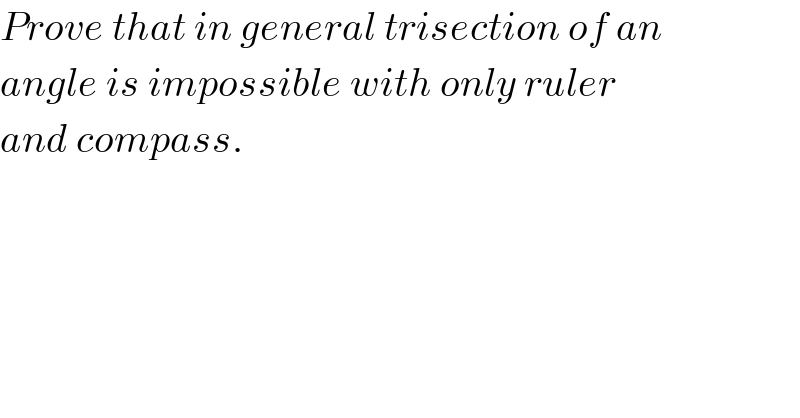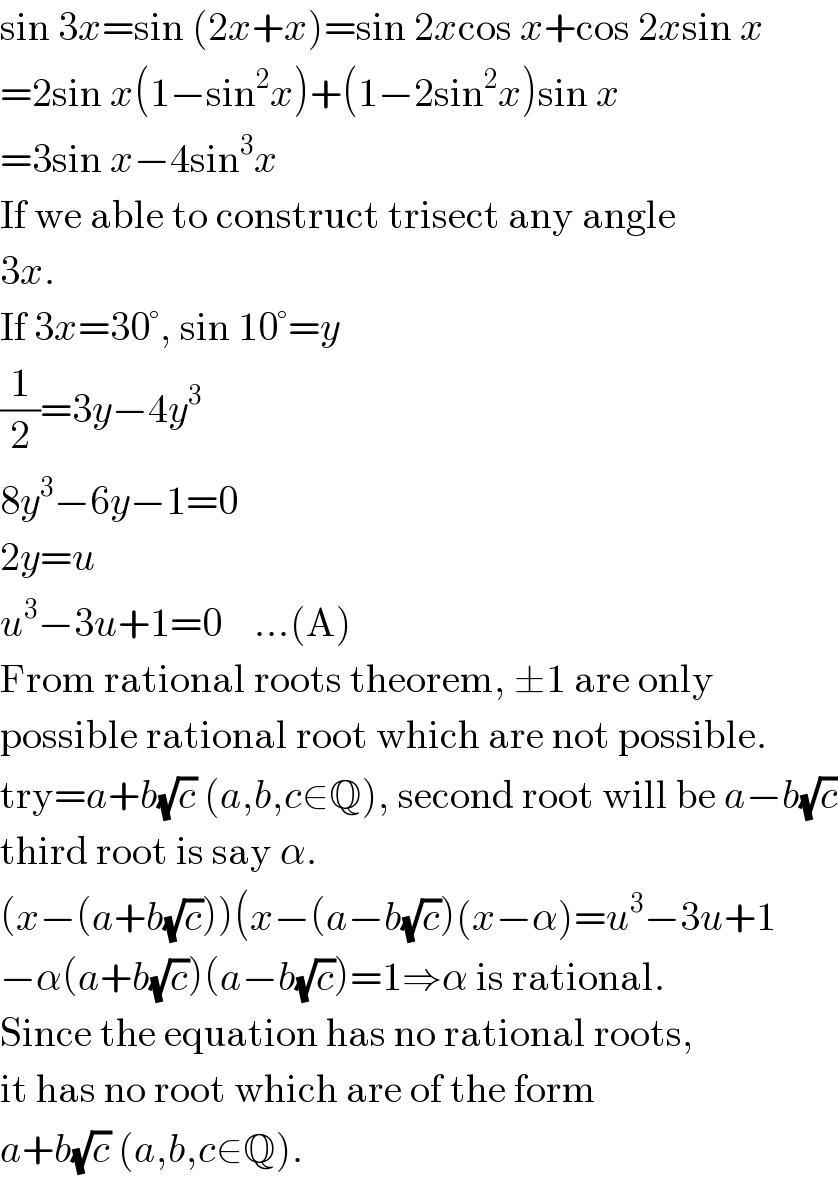Question Number 3467 by Rasheed Soomro last updated on 13/Dec/15

$${Prove}\:{that}\:{in}\:{general}\:{trisection}\:{of}\:{an} \\ $$$${angle}\:{is}\:{impossible}\:{with}\:{only}\:{ruler} \\ $$$${and}\:{compass}. \\ $$
Commented by prakash jain last updated on 13/Dec/15

$$\mathrm{sin}\:\mathrm{3}{x}=\mathrm{sin}\:\left(\mathrm{2}{x}+{x}\right)=\mathrm{sin}\:\mathrm{2}{x}\mathrm{cos}\:{x}+\mathrm{cos}\:\mathrm{2}{x}\mathrm{sin}\:{x} \\ $$$$=\mathrm{2sin}\:{x}\left(\mathrm{1}−\mathrm{sin}^{\mathrm{2}} {x}\right)+\left(\mathrm{1}−\mathrm{2sin}^{\mathrm{2}} {x}\right)\mathrm{sin}\:{x} \\ $$$$=\mathrm{3sin}\:{x}−\mathrm{4sin}^{\mathrm{3}} {x} \\ $$$$\mathrm{If}\:\mathrm{we}\:\mathrm{able}\:\mathrm{to}\:\mathrm{construct}\:\mathrm{trisect}\:\mathrm{any}\:\mathrm{angle} \\ $$$$\mathrm{3}{x}. \\ $$$$\mathrm{If}\:\mathrm{3}{x}=\mathrm{30}°,\:\mathrm{sin}\:\mathrm{10}°={y} \\ $$$$\frac{\mathrm{1}}{\mathrm{2}}=\mathrm{3}{y}−\mathrm{4}{y}^{\mathrm{3}} \\ $$$$\mathrm{8}{y}^{\mathrm{3}} −\mathrm{6}{y}−\mathrm{1}=\mathrm{0} \\ $$$$\mathrm{2}{y}={u} \\ $$$${u}^{\mathrm{3}} −\mathrm{3}{u}+\mathrm{1}=\mathrm{0}\:\:\:\:…\left(\mathrm{A}\right) \\ $$$$\mathrm{From}\:\mathrm{rational}\:\mathrm{roots}\:\mathrm{theorem},\:\pm\mathrm{1}\:\mathrm{are}\:\mathrm{only} \\ $$$$\mathrm{possible}\:\mathrm{rational}\:\mathrm{root}\:\mathrm{which}\:\mathrm{are}\:\mathrm{not}\:\mathrm{possible}. \\ $$$$\mathrm{try}={a}+{b}\sqrt{{c}}\:\left({a},{b},{c}\in\mathbb{Q}\right),\:\mathrm{second}\:\mathrm{root}\:\mathrm{will}\:\mathrm{be}\:{a}−{b}\sqrt{{c}} \\ $$$$\mathrm{third}\:\mathrm{root}\:\mathrm{is}\:\mathrm{say}\:\alpha. \\ $$$$\left({x}−\left({a}+{b}\sqrt{{c}}\right)\right)\left({x}−\left({a}−{b}\sqrt{{c}}\right)\left({x}−\alpha\right)={u}^{\mathrm{3}} −\mathrm{3}{u}+\mathrm{1}\right. \\ $$$$−\alpha\left({a}+{b}\sqrt{{c}}\right)\left({a}−{b}\sqrt{{c}}\right)=\mathrm{1}\Rightarrow\alpha\:\mathrm{is}\:\mathrm{rational}. \\ $$$$\mathrm{Since}\:\mathrm{the}\:\mathrm{equation}\:\mathrm{has}\:\mathrm{no}\:\mathrm{rational}\:\mathrm{roots}, \\ $$$$\mathrm{it}\:\mathrm{has}\:\mathrm{no}\:\mathrm{root}\:\mathrm{which}\:\mathrm{are}\:\mathrm{of}\:\mathrm{the}\:\mathrm{form} \\ $$$${a}+{b}\sqrt{{c}}\:\left({a},{b},{c}\in\mathbb{Q}\right). \\ $$
Answered by prakash jain last updated on 13/Dec/15

$$\mathrm{As}\:\mathrm{sin}\:\mathrm{10}°\:\notin\mathbb{Q}\:\mathrm{and}\:\mathrm{not}\:\mathrm{of}\:\mathrm{form}\:{a}+{b}\sqrt{{c}},\:\mathrm{sin}\:\mathrm{10}°\:\mathrm{cannot} \\ $$$$\mathrm{be}\:\mathrm{drawn}\:\mathrm{using}\:\mathrm{ruler}\:\mathrm{and}\:\mathrm{compass}. \\ $$$$\mathrm{So}\:\mathrm{30}°\:\mathrm{cannot}\:\mathrm{be}\:\mathrm{trisected}. \\ $$
Commented by prakash jain last updated on 13/Dec/15

$$\mathrm{However}\:\mathrm{you}\:\mathrm{can}\:\mathrm{trisect}\:\mathrm{54}°\:\mathrm{since}\:\mathrm{sin18}°=\frac{\sqrt{\mathrm{5}}−\mathrm{1}}{\mathrm{4}} \\ $$
